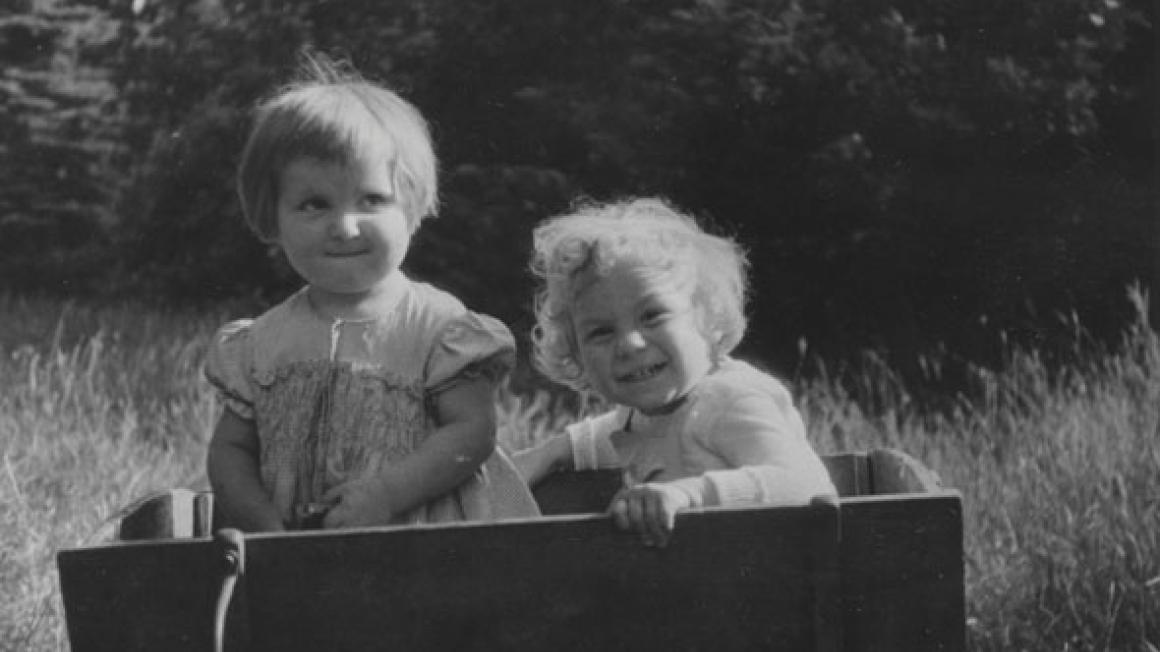Hitler’s Forgotten Children
Initially set up as a welfare programme for wives of SS members, eventually this increased to include unmarried expectant mothers, if they could prove the parentage of their child to be ‘racially valuable’. For unmarried women this gave them a chance to give birth without the social stigma usually fixed upon single mothers. It’s estimated through what little documentation survives (much documentation was destroyed when defeat for Germany looked certain) that 60 per cent of the mothers who gave birth in the programme were unmarried. A number of Lebensborn homes and orphanages were created for the children of the mothers who did not want to keep them. The children were then placed with ‘suitable’ families.
Finding that this was not sufficient in boosting the flagging population, the programme took a sinister turn. Lebensborn was extended into several of the occupied territories now under Nazi rule. Families were ordered to bring their children for ‘medical testing’, or in reality a crude assessment of their ‘racial value’ and children who were deemed ‘racially worthy’ were taken away from their parents and put into the homes of suitable German families. Now children weren’t just being bred, they were being stolen.
Without much of the documentation surviving (indeed at the Nuremberg trials there was no hard evidence in relation to child kidnapping numbers in Poland), it is impossible to know exactly how many children were stolen from their parents, but historians believe it could be as many as 500,000.
Ingrid von Oelhafen was one of the children who was stolen by the programme. ‘I was nine months old when I was taken away from my family,’ she tells me.
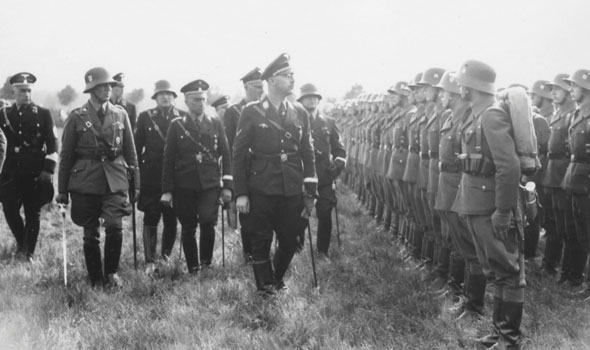 Heinrich Himmler inspects SS troops
Heinrich Himmler inspects SS troopsOriginally from Yugoslavia, Ingrid, then known as Erika, was taken from her parents Johann and Helena Matko; her two siblings remained with them. She was then put into one of the Lebensborn homes until at twoand- a-half, she was fostered by Gisela Andersens and her husband Hermann von Oelhafen. By the end of the war, the couple had separated and Ingrid was living between both their homes and children’s homes.
Ingrid’s book, Hitler’s Forgotten Children, details her fascinating history and the journey she went on to find her real family. ‘In Germany they don’t know a lot about Lebensborn and that generation didn’t talk to their children. I think that the young generation, they are interested, so I think they should know.’
In fact Ingrid feels that we can still learn from Lebensborn. ‘The Himmler programme wanted to make a new race and I think that’s the same today,’ she continues, ‘they make sperm banks and they try to change genes and I think this is just what Hitler wanted and I think the younger generation has to think about what that means for their children.’
It was at the age of 11 that Ingrid began to find out the truth about her life. On visiting the doctor with her father, she was addressed as Erika Matko. Having no idea why she had been called by that name, she asked the housekeeper who had been taking care of her. She was told that the people she had called her parents were in fact, foster parents.
‘I don’t recall being upset discovering the truth about myself,’ she says.
Despite this, she did wonder where she had come from, but decided not to mention it to Hermann and Gisela. ‘Life carried on as before.’
A decade after the war had ended the Red Cross set about reuniting families who had been separated by war. At the age of 15, Ingrid saw her face staring out at her from a poster, in a bid to reunite her with her parents. ‘It was, to say the least, a shock. I had to look at it [the poster] many times.’
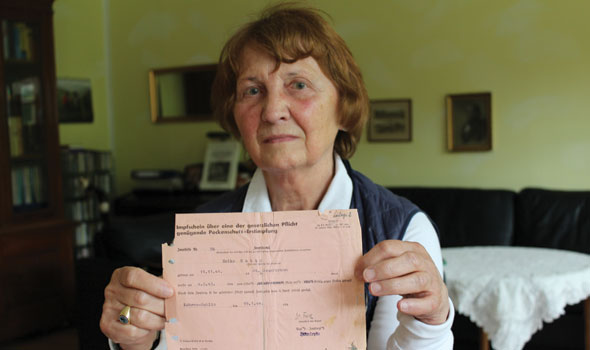 Ingrid with the first official document of her existence, a Lebensborn vaccination certificate issued by Lebensborn
Ingrid with the first official document of her existence, a Lebensborn vaccination certificate issued by LebensbornDespite seeing this – and finding out she was adopted, it took decades and a call from the Red Cross for her to start looking for her roots. ‘When I was 58, the German Red Cross called me and asked me if I would be interested in finding my real parents and of course I said yes.’
Having found documents in her mother’s room and leaving them, Ingrid now looked closely. A vaccination certificate signed in 1944 in Kohren-Sahlis showed that Ingrid (or Erika Matko as she was registered on the form) was born in St Sauerbrunn. On turning the form over, an official stamp read Lebensborn Heim (home).
‘She never told me what she knew. But she must have known. I was so angry.’
But with so much documentation lost and many archives refusing access to what documents were left (access only became available in 2007), and despite the help she was given, the process of finding her family was a long and arduous one.
When she eventually found evidence buried in an archive she was ‘so happy. I was singing’.
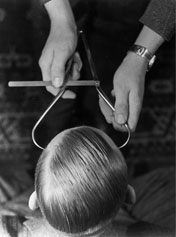 A boy’s head is measured during a racial examination in 1937After more searching and DNA tests, at the age of 72, she eventually located her family in Slovenia.
A boy’s head is measured during a racial examination in 1937After more searching and DNA tests, at the age of 72, she eventually located her family in Slovenia.On finding out the truth, she says, ‘I was content with who I was, I could stop searching. I finally found myself.’
But did she feel any connection with her real family once she had found them?
‘No. They are very nice and I meet them every year but they’re not like family, more like friends. I’m not involved in that whole life, I went to school and I made friends in Germany, that’s the life that has the connection for me.’
Ingrid’s research showed that when she was taken away her parents were given another child who would become the new Erika and was brought up in the life Ingrid might have had. ‘I knew there was another Erika Matko in Slovenia, I wrote to her but she never answered.’
‘I hated her for a time because she didn’t want to talk to me. I wanted to know what my mother was like, I was told she was a good housewife and things like that but I wanted to know how her heart was, because she never looked for me.’
‘I think she [Erika] was just very scared,’ she concludes.
Does she ever wonder what life would have been like if her fate had been different? ‘I thought about how it would have been, I can’t quite imagine it.
‘It’s a small town [where her parents lived] and I think I had a better life with my foster parents because I could do the hobbies I wanted to and go to school.’
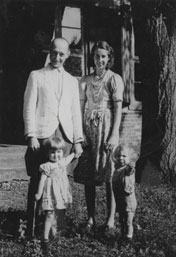 Hermann and Gisela von Oelhafen with Ingrid and Dietmar, Bandekow, summer 1944‘It would have been a more difficult life but maybe I would have had more love in Slovenia,’ she continues.
Hermann and Gisela von Oelhafen with Ingrid and Dietmar, Bandekow, summer 1944‘It would have been a more difficult life but maybe I would have had more love in Slovenia,’ she continues.‘I don’t think that I would have had this chance in Slovenia. My family were glassmakers and I think I would have been pushed in that direction. I wouldn’t have had a good chance if I had wanted to do something different.’
Even though she may not have a connection with her maternal family she does now use her family name in with her own.
‘The name I use is Ingrid Matko von Oelhafen but I always say von Oelhafen because I grew up with that name and I identify with the name.’
When I ask her what her advice is to other Lebensborn children who may not have found out about their past, it would appear that she may agree with the saying ‘ignorance is bliss’.
‘I think some people have no interest in looking for their past, and some of them are happy as they are and have had a good life. I would say if people are unhappy then they should find out about their past.’
For Ingrid, knowing that her upbringing was the result of a political situation and not a lack of love is the final closure.
‘I’m just glad that I know what happened and it was not that my mother didn’t want me.’
Hitler’s Forgotten Children, by Ingrid von Oelhafen and Tim Tate, is published by Elliott and Thompson, priced £14.99.



